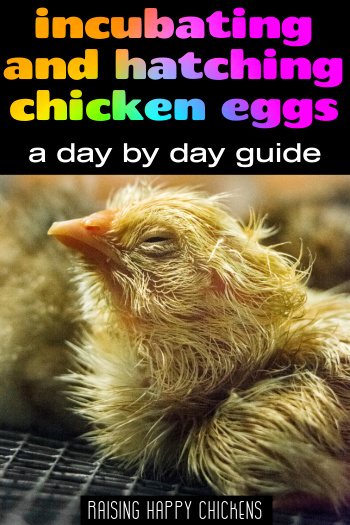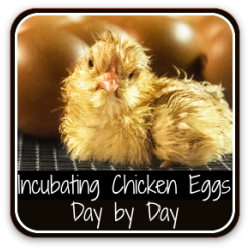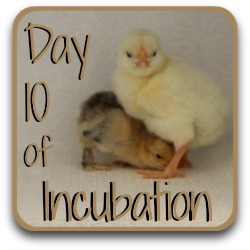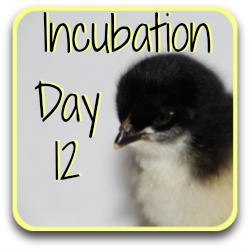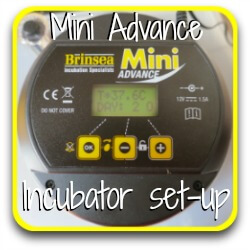- Home
- Incubation day by day
- Day 11
Incubating chickens' eggs: day 11 in the incubator.
Today marks the halfway point of incubation. The chick is fully formed and will spend the next half of the process developing its already present organs.
It's also becoming more active, as its heart beats strongly enough to move it around in the liquid allantois.
Remember, though, that incubating chickens is not an exact science. Embryos develop differently, depending on breed, the health of the egg prior to incubation, and conditions in the incubator.
So if you're not seeing the exact replica of images in this article, don't panic! Your chick is likely to be fine.

Halfway through the process. What's going on in the incubated egg today?
- Yesterday, the embryo looked like an alien. The head and in particular the eyes were so much larger than the body and looked out of proportion.
- If we were able to look inside the egg today, we'd see the start of the body growing larger. Now the proportions are evening out, the chick looks more like a chick!
- As we'll see in the candling section, it's becoming more difficult to see any definition of the embryo. The chick is growing so big that it's filling a large part of the egg.
Incubating chickens' eggs: what's happening to the chick at day 11?
Development now is really starting to speed up.
- Externally, the legs and toes are both growing. The bones begin to harden, depending on calcium taken from the shell.
- The legs are starting to develop scales, and the toes are curling.
- The tiny comb on top of the head begins to grow a serrated edge.
Please note: the image below is a commissioned piece and is subject to international copyright laws. I am the sole copyright owner.
It must not be used, copied or reproduced anywhere without my permission.
Contact me for details and permissions for this and all other images on this page.
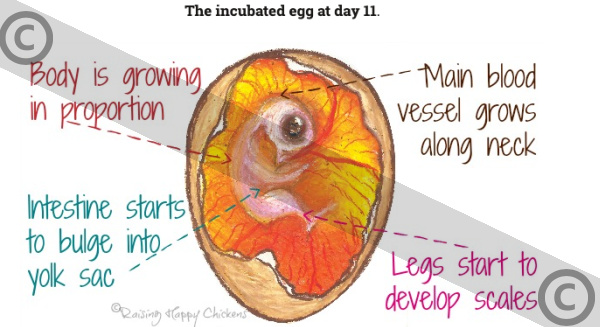
- Internally, the blood supply is increasing and the main blood vessel – the aorta – can be seen along the neck.
- The heart is developing further and has separate chambers. The heartbeat remains constant at around 260 – 280 beats per minute. As the egg cools during candling, it will slow to 180 – 190 to conserve energy. (See sources).
- The chick's intestine now begins to push its way into the yolk sac. This will be a critical point when it comes to hatching: the embryo must re-absorb the yolk and its insides into itself before it hatches. If it doesn't, it will die.
- Which is why, when the time comes, we will not help a chick out of the egg, even if we think it may be distressed, unless we are very sure indeed that this phase has been fully accomplished.
What can we see if we candle the egg at day 11?
Make sure when candling incubated chicken eggs that you observe strict hygiene processes. Eggs become porous during incubation, and bacteria are easily transmitted through the shell.
- Use a good quality, medicated hand sanitiser. (This is an affiliate link which means that if you click the link and buy a product, I earn a small commission).
- Ensure all surfaces, including the candler, are kept spotlessly clean.
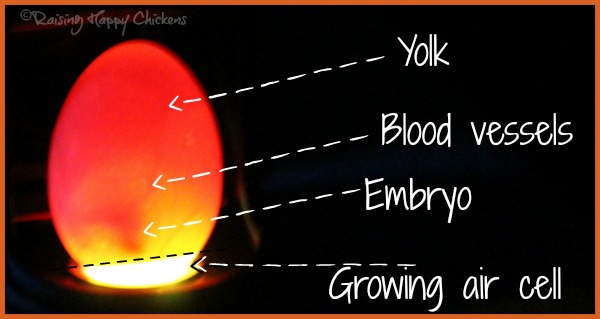
The blood vessels are now much denser than previously, and the embryo's growth added to that means there's little to see from now on.
We will just be able to see a growing dark area (which is the chick), an enlarging air cell, and for the next couple of days, part of the still developing blood supply.
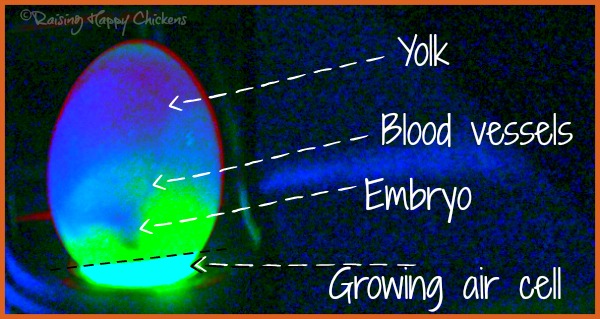
These strange colours, made by altering saturation levels on the same photograph, show the embryo and the main blood vessel a little more clearly.
The green area is the albumen which is growing smaller each day.
What should we be doing at day 11 when incubating chickens' eggs?
* Today's not a day for doing anything except checking, as usual, that the temperature and humidity levels in the incubator remain constant and stable.
* For 'fan assisted' incubators such as the Brinsea Mini Advance, this means a temperature of 37.5ºC (99º – 99.5ºF) and a humidity level of around 45%.
* Brinsea make this easy to do by checking the readings on the incubator lid. If your incubator doesn't, invest in a good thermometer / hygrometer. (This is an affiliate link, which means if you click and buy, I earn a small commission).
* If you have a 'still air' incubator without a fan the temperature should be between 38º and 39ºC (102ºF). Humidity should be the same at about 45%.
* The eggs should still be turned several times a day.
Can anything go wrong at this stage of incubating chickens' eggs?
This period of incubation isn't generally characterised by things going wrong – although development can stop at any given point.
But as long as your eggs were developing normally at the point you last candled them, and if the temperature, humidity and turning needs are being met, there shouldn't be an issue at this point.
Question of the day.
I'm incubating Welsummer chicken eggs and I've heard they should be incubated at a different temperature. Is that right?
No. All chicken eggs are incubated at the same temperature. Other types of poultry such as ducks and geese have different incubation needs.
The only issue with Welsummer eggs is their colour being so dark can make candling difficult. If I'm not able to see inside my Welsummer eggs I'm incubating, I leave them in the incubator until at least day 21 and hope they hatch.
Which the little Welsummer chick below did, along with several of her brothers and sisters! (Notice the light coloured "egg tooth" still present at the tip of the beak at day 2 post hatch).
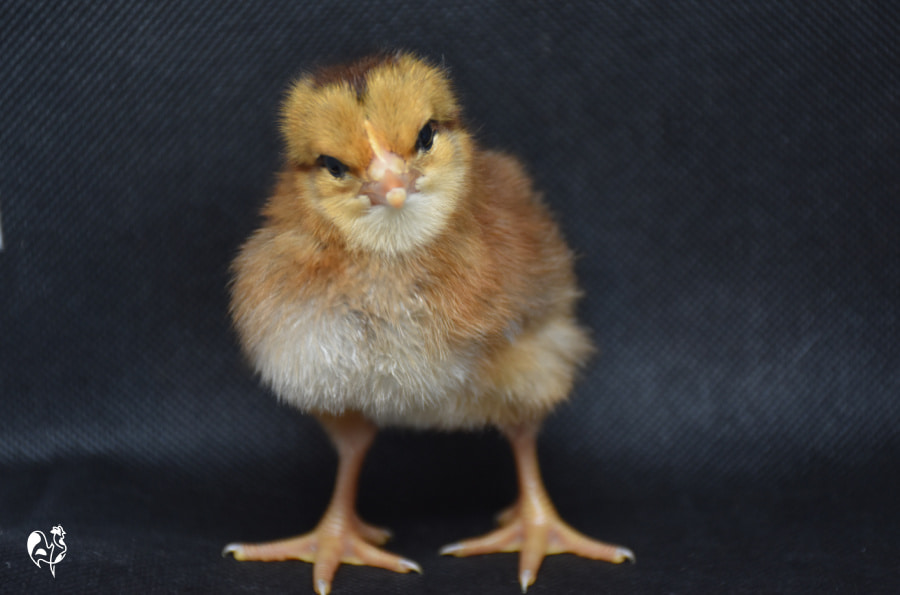
Where to next?
To go back to the start of incubating chickens' eggs, use the first button link. To return to yesterday (day 10) use the second. If you're ready to move on to tomorrow (day 12) use the third link.
Related pages you may find useful.
Sources.
A lot of "facts" you'll find on the internet are often people's individual views, based on inaccurate information repeated from poor quality sources.
The information I provide in this article and others is based on both my own experience of incubating and hatching chicken eggs every year for over 13 years, but on evidenced facts from scientific, peer-reviewed research and books from highly respected and experienced poultry keepers such as Gail Damerow.
Some of the trusted sources I have used in this article are these.
Avitronics: Heart Rates. Pub. Avian ID, 2020.
Damerow, Gail: Hatching and Brooding Your Own Chicks. Pub. Storey, 2013. See my review, here.
Hall, C., et al: A new candling procedure for thick and opaque eggs and its application to avian conservation management. Pub. Journal of Zoobiology, 2022.
Hamburger, V and Hamilton, H L: A series of normal stages in the development of the chick embryo. Pub. Journal of Morphology, 1951.
Pescatore, T, and Jacob, J.: Development of the Chick. Pub. University of Kentucky, College of Agriculture, 2019.
Swann, G., and Brake, J.: Effect of Incubation Dry-Bulb and Wet-Bulb Temperatures on Time of Hatch and Chick Weight at Hatch. Pub. Journal of Poultry Science, 1990.
Tona et al: Chicken Incubation Conditions: Role in Embryo Development, Physiology and Adaptation to the Post-Hatch Environment. Pub. Frontiers in Physiology, 2022.
- Home
- Incubation day by day
- Day 11
